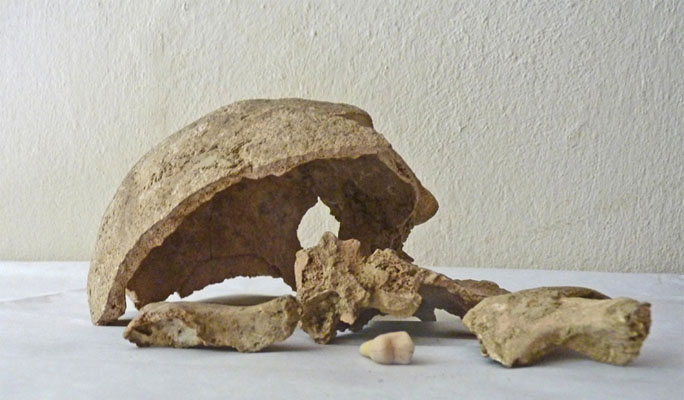Osteology and prehistory

Why should we study bones?
The study of skeletal findings allows for a direct reconstruction of the living conditions of lost populations. This kind of study can be carried out at various levels: morphologic, histologic, biochemical and molecular. To give an example, from the macroscopic, histological and radiographic study of the lesions on the skeleton, it is possible to trace the diseases that affected the populations of the past and to understand the origin and diffusion of the former through the identification of bacterial DNA. The lesions on the skeleton can lead to diagnose traumatic episodes, consequences of conflicts between individuals. The so-called 'stress markers' present on the skeleton and related to repetitively performed movements, posture and mechanical load borne during life can inform us about the type of work done and offer the instruments to formulate reconstructive hypotheses about the economy, the lifestyle and the division of labor within ancient societies. The analysis of the stable isotopes of carbon and nitrogen on human skeletal remains of populations of the past, focus on the ability to associate the isotopic ratio of these elements with large classes of foods so as to generally reconstruct their diet.
At the origins of populations
The study of the human skeleton is also useful for the identification of the origin of populations and of the existing relations between them. For example, the structure of the dental tubercles, as well as some non-metric skeletal characters, being genetically determined, can be used as markers of affinity and migration, while the dating of the bone tissue with the radioactive isotope method allows to attribute an age to finds.
The skeletal remains also offer the possibility of analysing ancient DNA, used to identify the genetic characteristics of contemporary aboriginal populations with the aim of determining their origin and migration routes.
The ability of the human skeleton to respond to internal and external stress and to preserve a trace of it therefore makes the osteological collections an exceptional and irreplaceable anthropological archive.
The Collections
The series of skeletal finds from prehistoric - protohistoric times (from the Middle Paleolithic to the Iron Age included), are constituted for the vast majority by Etruscan skulls coming from various places, especially in the provinces of Siena and Grosseto. These were acquired by the museum in the years immediately following its foundation. The Neolithic finds from the excavations of Ettore Regàlia on the island of Palmaria, on the other hand, date back to the beginning of the 1900s.
Later, findings from the Middle Paleolithic period coming from Buca del Tasso (Lucca) became part of the museum collections, as well as about fifty finds from the Eneolithic age from various burial caves (Le Pianacce, La Tana) in the municipality of Camaiore ( Lucca). Also dating back to the Eneolithic age are 20 finds from the Grotta di Equi, in the Lunigiana region.
A large number of skeletal series of the Eneolithic culture of the Rinaldone (about 80 artifacts) comes from various sites in the province of Grosseto and Upper Lazio (Ponte San Pietro, Garavicchio, Chiusa d'Ermini, La Porcareccia), the result of joint excavations by E. Rittatore and Luigi Cardini, conducted between the mid-1950s and early 1960s.
Moreover, among the prehistoric collections, there is a considerable quantity of finds probably from the Neolithic period, dating back to the excavations conducted at the end of the 19th century by N. Morelli and A. Issel to the Grotta delle Arene Candide, and from G.B. Rossi to Grotta Pollera.
These collections are the subject of constant research, thanks to the collaboration of prof. Jacopo Moggi Cecchi from the Department of Biology of the University of Florence.
SMA contact person: Monica Zavattaro
Last update
07.09.2021
